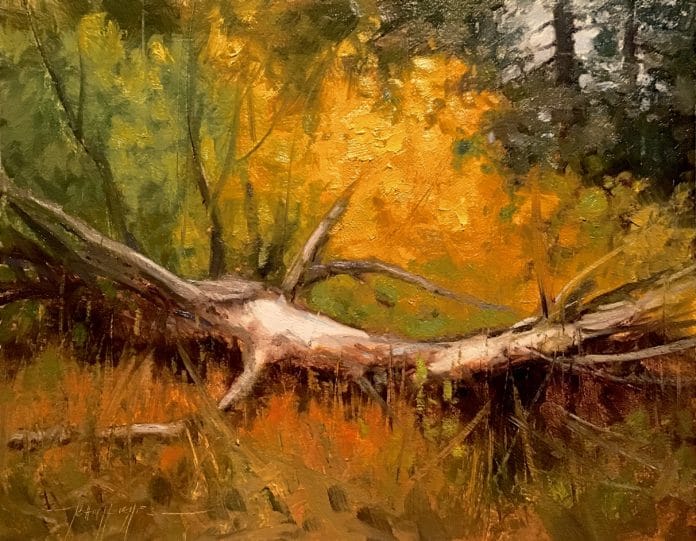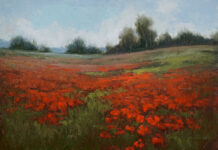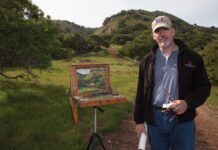Normally I focus my remarks on the painting process, but today I would like to take a moment and wax poetic on the subject of painting in a more general sense. I am mainly directing this to young aspiring artists who are trying to find themselves artistically. That journey can be a long one and involves discovering both how to paint and why we paint.
In many institutions over the past decades, concept has so eclipsed craft that the visual arts have become more about social commentary than beauty. For me and many others, the role of social commentary is fine for social commentators; but I’m not generally thrilled about art as social commentary. My question really comes down to, What are we artists trying to say with our work, and is the message more important than the execution? Some artists feel the need to use their creative output to make a statement that causes other people to think; this approach sometimes makes me wonder if there is a shortage of newspapers.
By now you are probably thinking that commentary in art always rubs me the wrong way. Not necessarily. For instance, I am reminded of the story of an alleged meeting between Pablo Picasso and Joseph Goebbels at the 1937 Exposition Internationale des Arts et Techniques dans la Vie Moderne, in Paris, where Picasso’s famous mural depicting the bombing of Guernica was on display. Legend has it that Goebbels walked up to the artist and asked if he was responsible for the painting. Picasso replied, “No, you are!” I don’t know if the anecdote is true, but I would like to think so, and would have loved to have been a fly on the wall that day.
Some years ago, while a student at a California college, I had the experience of observing (like a “fly on the wall”) an interesting exchange between a fellow student and our painting professor, who was a renowned artist in the local area. The student mentioned that he had recently seen one of the professor’s large paintings on display in a public building. While there, the student noticed a couple of older women who were shocked by the painting, which depicted a much distorted representation of a human form, dressed in a flamboyant costume. Hearing of the women’s reaction, our professor swooned in joyous ecstasy while exclaiming, “That’s the reason I paint!”
I really had to wonder if that was reason enough! Compared to Picasso, what was his message? Furthermore, what did his remark say about his love of art, the excitement of a well-placed brush stroke, the satisfaction of mastering the craft of painting, the sheer joy of expressing an emotion? Was his reason for painting really just about its shock value!
To be quite honest, when I viewed his paintings, I wasn’t struck so much by the content of his expression as by the lack of paint quality and handling of the medium. The whole thing became clear to me one day when he said that I was doing well in his class, but that I had to hasten the rate of my development as an artist. I couldn’t help but wonder how that concept worked? He said that I needed to speed up the process, because there was no time for learning, in the traditional way. I figured at that point he was referring to content over craft.
I don’t want to give the impression that this artist had nothing to offer as a teacher; he did, and I really liked the man on a personal level. Unlike some professors I’ve heard of, he gave me the space to paint what I was interested in, and he was generally supportive of my goals as an artist; I truly thank him for that. Nevertheless, after that experience I resolved to seek out an art education anywhere and everywhere that I could!
The Scottsdale Artists’ School and numerous other workshop venues, copious trips to museums and art galleries, along with mountains of books and tapes and associations with many good artists made up the bulk of my experience in gathering knowledge of painting thought and practice. I would never say that I was self-taught, because, as the saying goes, I would have had a poor instructor! Self-directed study is a more accurate description of what I went through in this quest to gain knowledge.
One very important thing I’ve learned over those years is that knowledge is not the sole property of institutions of higher learning. That is not to say that you can’t get some good training in some schools, but so much of what has been taught for many decades has been more concerned with content than craft. If that’s what you are experiencing in school, you might think about rounding out your education with some study on the side.
I know now that my art is an expression of what I love, what I feel, and who I am, coupled with a hard-won foundation in the craft of painting. I’ve learned that there are no artistic shortcuts, just lots of hard but rewarding work. Learning to paint well is a lifetime pursuit, just like learning to play an instrument, or any other discipline which requires mastery. Self-expression may be the goal, but self-discipline is the vehicle.
Social commentary in art is fine, if you have something important to say, but it’s not why most plein air painters paint. We could have chosen that, but chose instead to convey feelings and emotions about the land; perhaps that’s our commentary. It’s beauty that inspires us and has inspired many other artists — both living and dead — whom we admire. The beauty of how light affects various forms in the visual world, the beauty of expressing an emotional reaction to visual realities, through the manipulation of paint.
Having said this, I realize there are others whose painting goals are different, and that is perfectly okay. We can’t all be after the same thing; we are all free to make our own choices. Others are free to depict tragedy, hopelessness, satire, disrespect, or any number of human failings in their art. I figure we get enough of that on the 24-7 news cycle!
The great thing about Picasso and other artists of his generation was that they learned their craft first, and then went on to do what they wanted with it. Since those days, many aspiring artists have thought to bypass the craft, thinking that they could substitute raw emotion or commentary for quality. In music that would be the same as an untrained musician banging on the keyboard of a grand piano.
Whatever you decide your art will be about, I would encourage beginning artists to avoid the soapbox for a while and take the time to learn the fundamentals. There will always be a time and place for commentary.
What are your thoughts on this topic? Share them with us in the comments below.





Very well said! Unfortunately the old adage of those that can DO. THose that can’t TEACH and most in higher education today, fall into the latter category who bought in to the content and comment are everything notion.
Yes, I’m perplexed by the admiration many have of art instructors/artists affiliated with educational institutions but they have no understanding of what an art professional is and how difficult and time consuming the work of advancing and refining one’s craft is.
Beautiful painting an an eloquent commentary.
Very thought provoking great article John. I too want to express the beauty I see in the world and uplift the spirit of those who enjoy my artwork. But, I do find some commentary artwork quite interesting which forces me to explore what they want to convey without words. Knowledge behind the painting is what makes great artwork as you say, and to me that can be beauty or sometimes commentary which makes me think of Maynard Dixon’s Depression Period paintings. Great article.
An excellent article! Yes, the artist needs to exist before the art can make a statement. Too often in today’s society, that does not happen. Before the mid-1850s, artists spent years in training and devoted their lives to their craft. As realism / naturalism / representational art gains regains its importance, perhaps recognition of the artist’s craft will be the foundation for moving into social commentary and perhaps those assembling exhibitions of art commentary on social issues will put the “art” first, but I am not holding my breath.
Having worked in a small contemporary art museum for many years it is disheartening to see the quality of work displayed simply because the work supports the thesis of of the exhibition or curatorial decisions. The trend I see, as one who doesn’t make the decisions, is exhibitions that are more focused on political, social, or economic discussions. Work is chosen to support these discussions and to use the art to create dialogue on contemporary issues.Yet as a working artist, I have spent many years developing my skills and I know that there is a parallel art world out there that is very committed to traditional skills. Unfortunately it hasn’t yet resonated with those in power. Someday I’m hoping the trend will reverse itself again. No matter. I just keep recommitting, learning, and doing what I care about.
What an absolutely excellent article. It describes perfectly my philosophy and the reason I paint, both studio and en plein air. I have no reason to explain the piece with the exception of location, or perhaps an interesting title. It seems as though many exhibitions are not about the quality, or the years developing a well honed craft, but about how well the artist can craft a “story” to support the art, no matter the quality or subject. It is as if without the “story”, the art cannot stand on its’ own merit.
John, you just expressed what I have been thinking for many years. Of course we are not trying to devoid art of meaning beyond the craft, but to have a voice in art, one needs to throw oneself first into studying how to paint well, learning from past and contemporary artists, and humbling oneself before the weight of all there is to learn. I have seen too many articles on artists who apparently gained the public stage only because they jumped on a political or cultural soap box.
It all started with the Impressionists. I say they are the best and worst thing to happen to art. They were rebels but classically trained. Those that followed skipped the classical training and then became teachers and professors. So their inability to teach classical methods was disguised with rhetoric about the message. The message became more important than the skill. The last 100 years has been a sad state for the accomplished draftsman. But the tide has turned in recent years and classical realism is back.
Thanks, Some great comments here!
Right on.
I’ve often felt the same way, but then I think of this. Sometimes, when I need to emote, or pour out some inner agony my medium of choice is poetry. It’s probably very bad poetry, but as I rarely let anyone see it it works for me. I don’t have the “spark” of writing skills that would enable me to create fictional characters that live and move and speak, but I can use the shorthand of poetry to effectively express some pretty raw emotions.
I wonder if some of the more conceptually based artists do this visually? If so, is it just a new genre, a hybrid of art and newspaper? I also have to question, what makes us think that they cannot paint in the style of classical realism? Maybe they can, and choose not to?
I’d like to add this: You are right on about the “craft” aspect of painting. I went to an opening last night and saw work that drew me from across the room. When I got close, the paint quality and handling were not so good. This kept me from seeing the beauty of the work, almost like looking at a painting through a screen or chain-link fence. Thanks for a great article!
Hi Lisa,
I really appreciate you taking the time to jot down your feelings on what I wrote. These dialogues and sharing of perspectives is really great. Thank you so much, your opinions are valuable to me and others!
Thank you John for an interesting, thought provoking article (I have saved many of your works) and they always come across as honest, jargon free, sense. It’s brought out several good replies too. I’m not sure what you’d think of artists I love but whose brushwork sometimes falters. George Bellows, Francis Bacon, David Bomberg, Edward hopper, Franz Kline all speak of the human condition and visual excitement yet there are acres of academic paintings that are visual Mogadon. “Learning” to paint and “what” to paint are both lifelong and ever changing processes. Great article.
Hi Bill,
Thanks for the response! I appreciate your comment about my writing. My feeling on all of those artists you mentioned is that I wouldn’t want to attempt to sit in judgement on their work in any sort of universal sense, I’m sure I’m not qualified for that. I will tell you how I personally feel though. I’m drawn to Franz Kline and George Bellows along with Hopper. Some of what I’ve seen of David Bomberg I find visually compelling and Francis Bacon, for me gets into that content area too much. I have to say that abstract expressionism is fascinating, on a purely visual level. I had a few hours to kill in LA a couple of years ago and decided to stop by the MOMA to check out just that. Kline especially spoke to me for his edges, and a sort of nostalgia for the movement he painted in.
That probably sounds weird coming from the guy who just wrote this article, but it’s all about the visual experience for me and not so much the message. I think really good Realists owe a lot to the Abstract Expressionists, you can see it in their work. I guess that’s why I enjoyed reading “The Painted Word” so much!
I’m not sure I “sit in judgement”, I’m simply emotionally touched by some of their work- they all produced poor stuff occasionally (don’t we all-even Monet). Thanks again.
Thank you Everyone for your interesting comments!